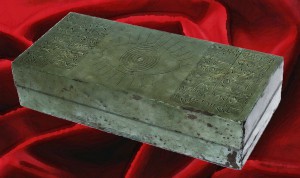An account by Doctor Maximilian von Borcke, as provided by Sean Patrick Hazlett
Art by Scarlett O’Hairdye
A disconcerting feeling of revulsion overwhelmed me when I touched the strange object, a metallic container the size of a cigar box. Inscribed on it was writing reminiscent of Sumerian cuneiform. The solitary eye engraved on the artifact’s face filled me with despair for reasons unknown to my conscious mind.
The weatherworn package had arrived yesterday from St. Petersburg’s Mineralogical Museum. I had ripped open the package before reading the attached letter, which was adorned in a script I immediately recognized. Since the war had begun, I’d feared I’d lost contact with my dear friend, Leonid.
My head ached and waves of nausea roiled in my gut. It was only after I returned the container to its package that my queasiness abated. I opened Leonid’s letter to learn his reasons for sending me this parcel.
Maximilian,
I wish I were writing you under better circumstances. Tomorrow, I join the Red Army to defend my Motherland against your countrymen. I regret we now find ourselves on opposite sides of this sad struggle. Know that I bear you no ill will. Your politicians are responsible for this fiasco, not you. I still cherish our friendship and scholarly correspondence. It is because of my deep admiration for you that I’ve sent you this package.
I implore you not to open it until you’ve read these words. Some things are best left undisturbed.
I shuddered. What horrors had I unleashed?
The artifact is of extraterrestrial origin. I discovered it in September 1908, during an expedition to Siberia’s Tunguska region. I found it amidst the destruction wrought by a meteorite that had laid waste to wide swaths of Siberian taiga. I passed the object along to my commander, and it ultimately made its way to the Tsar’s court in St. Petersburg.
The impact zone stretched for thousands of versts. There, we discovered queer metallic shards composed of elements unclassifiable on Mendeleev’s periodic table. We hauled samples to St. Petersburg for further examination.
I felt betrayed. I had accompanied Leonid on his “second” expedition to the Tunguska impact site in 1927. His first survey had supposedly been in 1921. Both lies.
The sensitive nature of our find led the Tsar to declare this expedition and one that followed secret. In 1914, one of the Tsar’s ministers ordered the second excursion to Tunguska. Our mission was to wipe the area clean of all extraterrestrial material.
I had always wondered why we hadn’t found any cosmic debris.
The Tungus peasants nearest the site were listless, pale, sickly, and seemingly soulless. Those some distance from the impact reported an eerie green fog that drove men mad. It’s difficult to put much stock into these stories, yet so many witnesses reported the same phenomena that they’re difficult to ignore. Most believe the metallic fragments were the cause. For humanity’s greater good, we collected them and transported them for burial in the bogs beyond St. Petersburg.
After the Revolution, the Soviets engaged in a deception campaign to dissuade other nations from exploring the Tunguska mystery. They sponsored my “initial” survey and the subsequent expedition open to outsiders like you. Forgive me for my dishonesty. I hope you understand my reasons for it given the delicate nature of these disturbing revelations.
I found Leonid’s tale to be both outrageous and intriguing. If his claims were true, I had in my possession an artifact of an advanced interstellar civilization. I read further, keen on divining Leonid’s purpose in placing this scientific wonder into my humble hands.
I sent you this relic because I trust your judgment. It has the potential to topple nations. Ignorance of its power poses a grave threat to humanity. I ask that you pass it on to scientists in America, as that nation is currently uninvolved in this wasteful European conflict. I trust they will safeguard it until the war ends.
To better times,
Leonid
My friend’s trust and my love for the Fatherland resulted in competing loyalties. I held the key to what could end years of bloodshed. Yet it was my friend’s confidence in me that placed it into my possession. I pondered for days about what to do. In the end, duty dictated my actions.

My head ached and waves of nausea roiled in my gut. It was only after I returned the container to its package that my queasiness abated. I opened Leonid’s letter to learn his reasons for sending me this parcel.
To read the rest of this story, check out the Mad Scientist Journal: Autumn 2013 collection.
Doctor Maximilian von Borcke earned his doctorate in mineralogy at the Humboldt University of Berlin in 1920, where his dissertation focused on the electromagnetic properties of rare earth metals. Shortly thereafter, he completed his habilitation on the electrochemical applications of exoplanetary elements. From 1943 to 1945, he served under Minister of Armaments and War Production Albert Speer synthesizing alloys with extraterrestrial metals to create special munitions for the Wehrmacht’s rail gun program. The Red Army captured him in 1945 and transferred him to Kapustin Yar where he developed advanced materials for the Soviet space program until his death in 1974.
Sean Patrick Hazlett is a technology analyst and Army veteran living in the San Francisco Bay Area, where he considers writing fiction as therapy that pays for itself. His fiction has appeared in Plasma Frequency Magazine, The Colored Lens, and NewMyths.com (forthcoming). For more information, please visit: reflectionsofarationalrepublican.com.
Scarlett O’Hairdye is a burlesque performer, producer and artist. To learn more, visit her site at www.scarlettohairdye.com.
Follow us online: